Research on the Throttling Performance and Anti-Erosion Structure of Trapezoidal Throttle Orifices
Abstract
:1. Introduction
2. Mathematical Model
2.1. Continuity and Momentum Equations
2.2. Turbulence Model
2.3. Erosion Model
2.4. Wall Collision Recovery Equation
3. Optimized Design of Throttle Orifice Shape
4. Evaluation of Trapezoidal Orifice Throttling Performance
4.1. Grid Independence Test of Throttle Orifices
4.2. Comparison of Throttle Differential Pressure of Different Shapes of Throttle Orifices
4.3. Effect of the Trapezoidal Throttle Orifice Taper on Differential Pressure
5. Effect of the Trapezoidal Throttle Orifice’s Taper on Erosion
5.1. Erosion Calculation Domain Model
5.2. Erosion Boundary Conditions
5.3. Flow Field Analysis
5.4. Analysis of Erosion Results
- (1)
- For throttle orifices with different tapers, the erosion rate shows a trend of increasing and decreasing with the particle diameter increase.
- (2)
- The erosion rate changes slowly in the particle diameter interval of 0.05–0.25 mm. As in Figure 16c, the erosion rate of 6% sand content increased by 66.7%. The reason is that at smaller particle diameters, the particles have less mass and are more affected by the turbulence intensity of the fluid. Therefore, the particles follow the fluid movement more strongly and hit the wall less often.
- (3)
- In the particle diameter interval of 0.25–0.45 mm, the growth of the erosion rate is accelerated. For example, in Figure 16c, the erosion rate of 6% sand content increased by 146.7%. The reason is that the kinetic energy also gradually increases with the gradual increase in the mass of the particles. As the kinetic energy of the impact of the particles on the wall increases, the resulting erosion pits gradually increase.
- (4)
- As the size of the particle increases further (>0.45 mm), the mass of the particle becomes non-negligible. The reduced fluid following of the large mass of particles affects the kinetic energy, and the erosion rate decreases. All the throttle orifices with different tapers are subjected to maximum erosion at a sand particle diameter of 0.45 mm.
6. Discussion
7. Conclusions
- For the same throttle area, the differential pressure of the trapezoidal orifice is about 18.6% higher than that of the traditional rectangular orifice. The result proves that the trapezoidal orifice has excellent throttling performance.
- The throttling differential pressure of the trapezoidal throttle orifice increases with the increase in the taper. When the taper increases from 10° to 30°, the differential pressure increases from 0.347 MPa to 0.409 MPa. For a differential pressure of 0.03 MPa, the production of natural gas increases with the taper. When the taper is increased from 10° to 30°, the production of natural gas increases from 11,976 m3/d to 12,374 m3/d, an increase of only about 3.3%. Overall, the effect of the change in the taper on gas production is small and negligible.
- When the particle size is 0.45 mm, the trapezoidal throttle orifice is subjected to maximum erosion. In the 0 to 25° taper, the maximum erosion is the first to decrease and then increase as the taper increases. The minimum erosion rate is achieved at about 20°. The above research methods can provide a theoretical basis for optimizing the size and structure of orifices and sealing the reliability of fluid control valves.
Author Contributions
Funding
Data Availability Statement
Conflicts of Interest
References
- Tan, L.; Xie, L.; He, B.; Zhang, Y. Multi-Fracture Propagation Considering Perforation Erosion with Respect to Multi-Stage Fracturing in Shale Reservoirs. Energies 2024, 17, 828. [Google Scholar] [CrossRef]
- Li, T.; Zhang, J.F.; Guan, Y.Z. Research Progress of Capacity Evaluation Techniques for Horizontal Well Segmental Fracturing in Various Segments. Sci. Technol. Eng. 2023, 23, 8916–8927. [Google Scholar]
- Yuan, J. New Progress and Development Suggestions of SINOPEC’s Horizontal Well Drilling Technology for Ultra-Long Horizontal Segments of Shale Gas. Pet. Drill. Tech. 2023, 51, 81–87. [Google Scholar]
- Cui, X.J.; Li, H.T.; Li, S.X.; Li, Y.F.; Ge, J.R.; Wang, N. Integrated Intelligent Completion Technology for Water Searching and Control in Horizontal Wells and Its Application. China Offshore Oil Gas. 2021, 33, 158–164. [Google Scholar]
- Eren, T.; Polat, C. Numerical investigation of the application of intelligent horizontal well completion. J. Nat. Gas. Sci. Eng. 2020, 83, 103599. [Google Scholar] [CrossRef]
- Li, R.F.; Zhang, L.; Liu, J.C.; Yang, J.Y. Research on Ground Control System of Intelligent Completion Technology. Shipbuild. China 2019, 60, 426–433. [Google Scholar]
- Zhang, M.F. Discussion on the development status and trend of intelligent completion technology. Mod. Chem. Res. 2017, 10, 14–15. [Google Scholar]
- Yang, Z.; Yang, J.; Wang, Q.; Sun, F.J. Research and Application of Plunger Airlift Draining Gas Recovery Intelligent Control Technology in Shale Gas Horizontal Wells. Chem. Technol. Fuels Oils 2022, 58, 554–560. [Google Scholar] [CrossRef]
- Giden, I.; Nirtl, M.; Maier, H.T.; Ismail, I.M. Horizontal infill well with AICDs improves production in a mature field—A case study. In Proceedings of the SPE Europec featured at 81st EAGE Conference and Exhibition, London, UK, 3–6 June 2019; pp. 85–90. [Google Scholar]
- Muradov, K.; Eltaher, E.; Davies, D. Reservoir simulator-friendly model of fluid-selective, downhole flow control completion performance. J. Pet. Sci. Eng. 2018, 164, 140–154. [Google Scholar] [CrossRef]
- Muradov, K.; Haghighat Sefat, M.; Moradi Dowlatabad, M. Fast optimization of packer locations in wells with flow control completions. J. Pet. Sci. Eng. 2021, 205, 108933. [Google Scholar] [CrossRef]
- Guo, D. Parametric Design and Analysis of Intelligent Downhole Flow Controller; Southwest Petroleum University: Chengdu, China, 2018. [Google Scholar]
- He, M.G.; Ma, F.M.; Lin, L.J.; Yin, G.F. Design of downhole smart throttler and flow field analysis of throttling valve. China Pet. Mach. 2013, 41, 85–89. [Google Scholar]
- Yang, Y.W.; He, D.S.; Xu, L.B.; He, Y.; Ye, Z.; Zheng, Y. Numerical Study on Flow Field Characteristics of Interval control valve in Intelligent Well. IOP Conf. Ser. Mater. Sci. Eng. 2019, 677, 42082. [Google Scholar] [CrossRef]
- Li, C.; He, D.S.; Yang, Y.W.; Xie, X.L.; Dai, H. Research on flow channel of downhole flow control valve based on Fluent. Pet. Mechanical. 2022, 50, 78–85. [Google Scholar]
- Zhou, J.H.; Zhang, Y.; Xiong, Z.Y.; Shang, J. Numerical simulation of throttling effect of throttling valves at the bottom of coalbed methane wells. J. China Univ. Pet. 2021, 45, 144–151. [Google Scholar]
- Li, C.H. Adaptability Evaluation of Horizontal Well Inflow Control Valve (ICD) Completion Technology; Northeast Petroleum University: Daqing, China, 2016. [Google Scholar]
- Chen, S.S.; Shi, P.Z.; Feng, Y.; Gai, J.A.; Lou, Y.S.; Di, X.P.; Shi, B.C. Prediction of erosion life of metal grid screen at different flow rates. China Pet. Mach. 2021, 49, 77–82. [Google Scholar]
- Zhao, J.G.; Wang, J.; Han, S.; Sahmani, S.; Safaei, F. Probabilistic-based nonlinear stability analysis of randomly reinforced microshells under combined axial-lateral load using gridfree strain gradient formulations. Eng. Struct. 2022, 262, 1–25. [Google Scholar] [CrossRef]
- Zhao, J.; Zheng, H.; Xie, C.; Xiao, X.; Han, S.; Huang, B.; Zhang, X. Research on the influence mechanism of fluid control valve on the production of segmented horizontal wells and the balanced gas production control model: A case analysis of Sichuan basin natural gas. Energy 2024, 294, 130837. [Google Scholar] [CrossRef]
- Carloni, A.C.N.; de Conde, K.E.; Pantaleão, A.V.; de Azevedo, J.L.F.; Rade, D.A. Validation and analysis of turbulence modeling in pipe elbow under secondary flow conditions. J. Braz. Soc. Mech. Sci. Eng. 2022, 44, 595. [Google Scholar] [CrossRef]
- Zhao, J.G.; Zheng, H.T.; Zeng, J.; Wang, G.R. Life prediction model of fracturing sliding sleeve based on Sichuan shale gas in China. Pet. Sci. Technol. 2023, 1–23. [Google Scholar] [CrossRef]
- Lian, Z.H.; Chen, X.H.; Lin, T.J.; Zhang, X.K. Study on erosion mechanism of sand discharge pipeline elbow joints. J. Southwest. Pet. Univ. 2014, 36, 150–156. [Google Scholar]
- Wang, W.; Sun, Y.; Wang, B.; Dong, M.; Chen, Y. CFD-Based Erosion and Corrosion Modeling of a Pipeline with CO2-Containing Gas–Water Two-Phase Flow. Energies 2022, 15, 1694. [Google Scholar] [CrossRef]
- Zhang, Z.; An, C.; Wei, D.F.; Wang, Z.G. Numerical simulation study on sand erosion of underwater throttling valve. Ocean. Eng. 2022, 40, 160–172. [Google Scholar]
- Edwards, J.K.; Mclaury, B.S.; Shirazi, S.A. Evaluation of alternative pipe bend fittings in erosive service. In Proceedings of the 2000 ASME Fluids Engineering Division Summer Meeting: Presented at the 2000 ASME FluidS Engineering Division Summer Meeting, Boston, MA, USA, 11–15 June 2000; American Society of Mechanical Engineers: New York, NY, USA, 2000. [Google Scholar]
- Wang, K.; Li, X.F.; Wang, Y.S.; Chen, Y.L.; Han, S.; He, R.Y. Prediction of the location of solid particles in liquid-solid two-phase flow on the erosion damage of a pipe bend. J. Eng. Thermophys. 2014, 35, 691–694. [Google Scholar]
- Grant, G.; Tabakoff, W. Erosion Prediction in Turbomachinery Resulting from Environmental Solid Particles. J. Aircr. 1975, 12, 471–478. [Google Scholar] [CrossRef]
- Li, B.; Zeng, M.; Wang, Q. Numerical Simulation of Erosion Wear for Continuous Elbows in Different Directions. Energies 2022, 15, 1901. [Google Scholar] [CrossRef]
- Zeng, J.; Zhu, H.Y.; Zhang, W.; Zheng, W.; Yang, Y.Q. Three-layer casing slip-on design and its erosion law analysis. Mach. Des. Res. 2018, 34, 181–186. [Google Scholar]
- Frosell, T.; Mcgregor, M.; Ross, C. A comparison of proppant erosion during slurry injection. Can. J. Political Sci. 2014, 43, 770–773. [Google Scholar]
- Kou, B.; Liu, E.; Li, D.; Qiao, W.; Chen, R.; Peng, S. Research on Erosion Characteristics of the Sleeve-Type Blowdown Valve in the Shale Gas Gathering and Transportation Station. SPE J. 2024, 29, 328–345. [Google Scholar] [CrossRef]
- Liu, P.; Wang, C. Selection and Optimization of Throttling Process for Ultra-high Pressure Gas Wells. J. Southwest. Pet. Univ. 2023, 45, 145–154. [Google Scholar]
- Zheng, J.; Li, J.; Wu, J.; Li, Z.; Zhang, Y. Review of Downhole Throttle Failure in Oil and Gas Wells. J. Fail. Anal. Prev. 2023, 23, 609–621. [Google Scholar] [CrossRef]



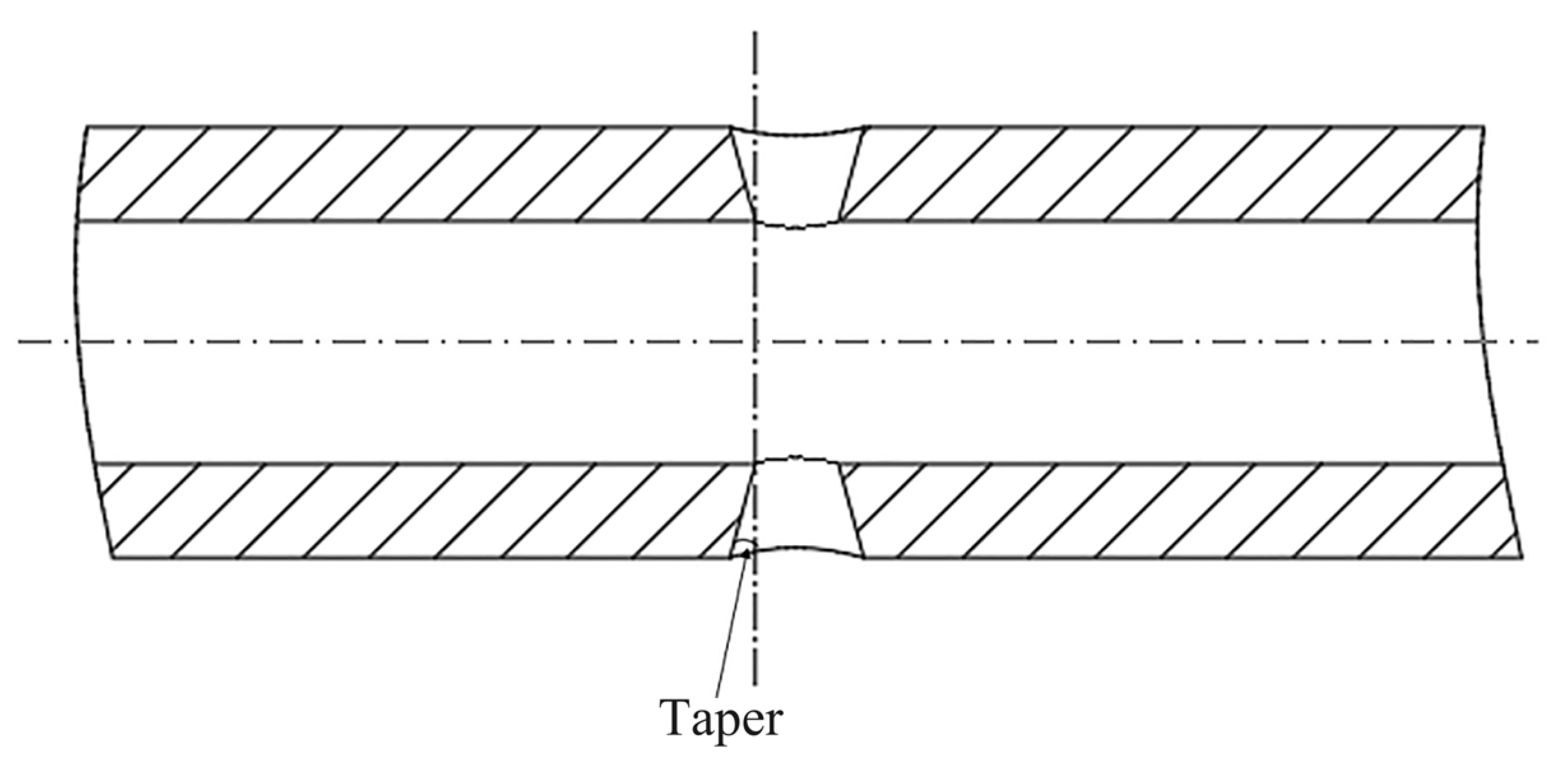




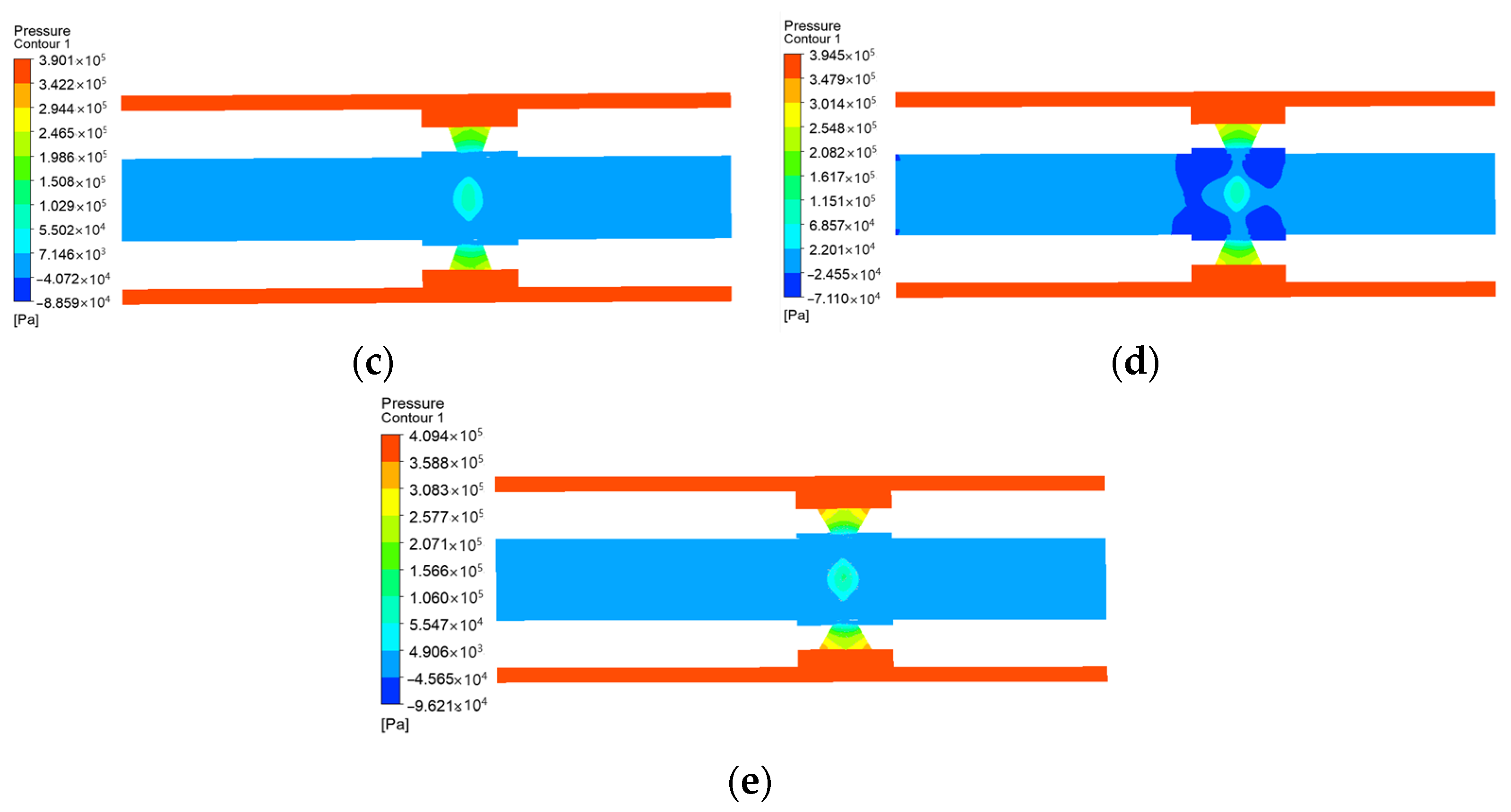



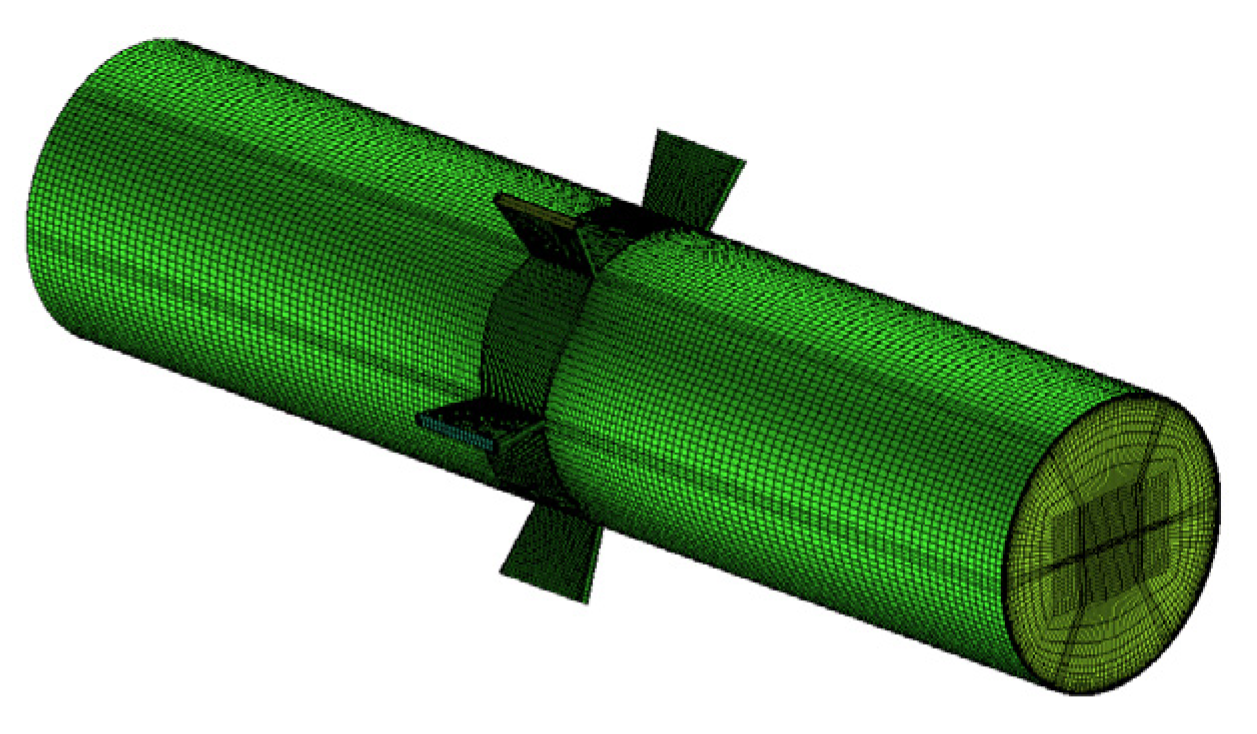

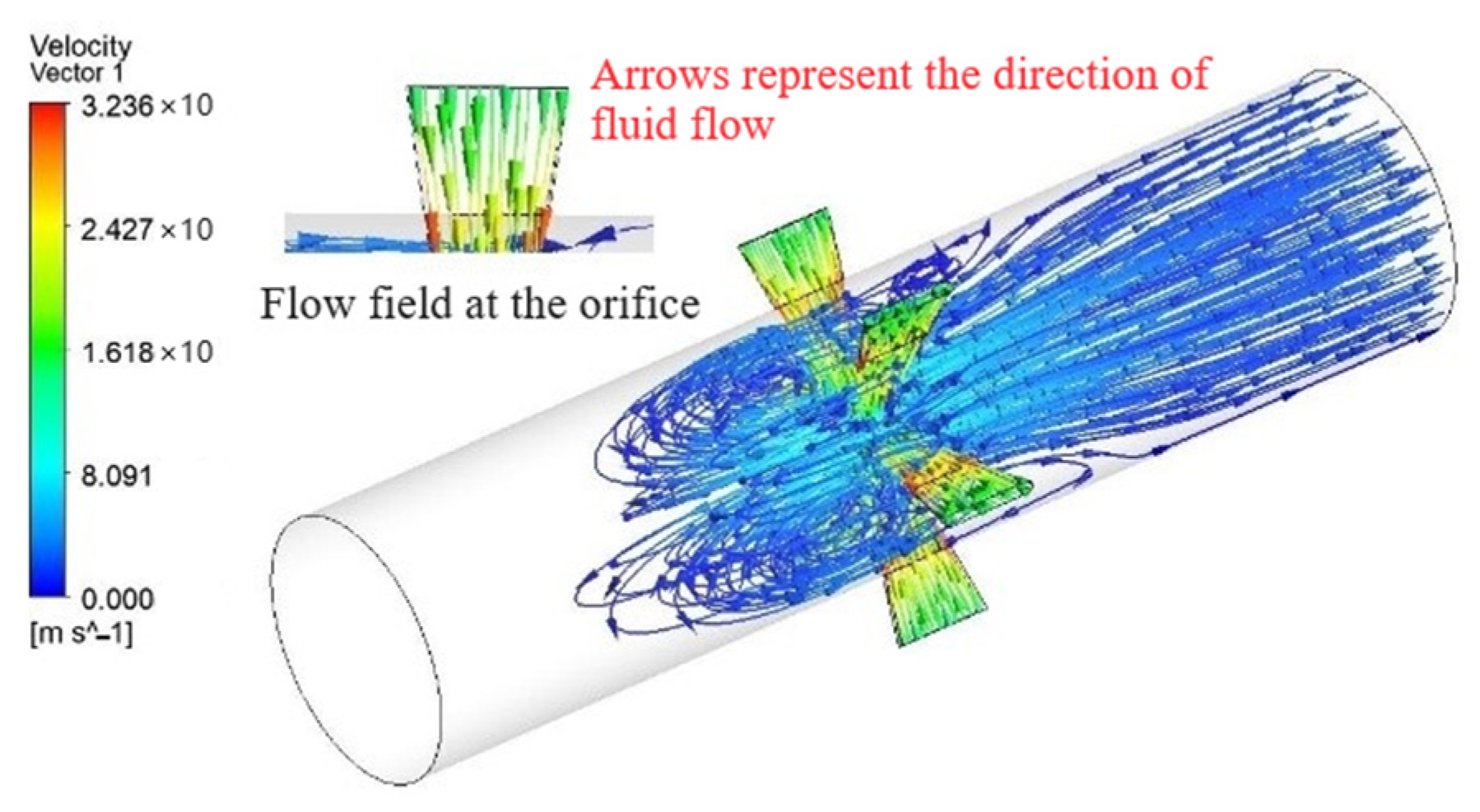
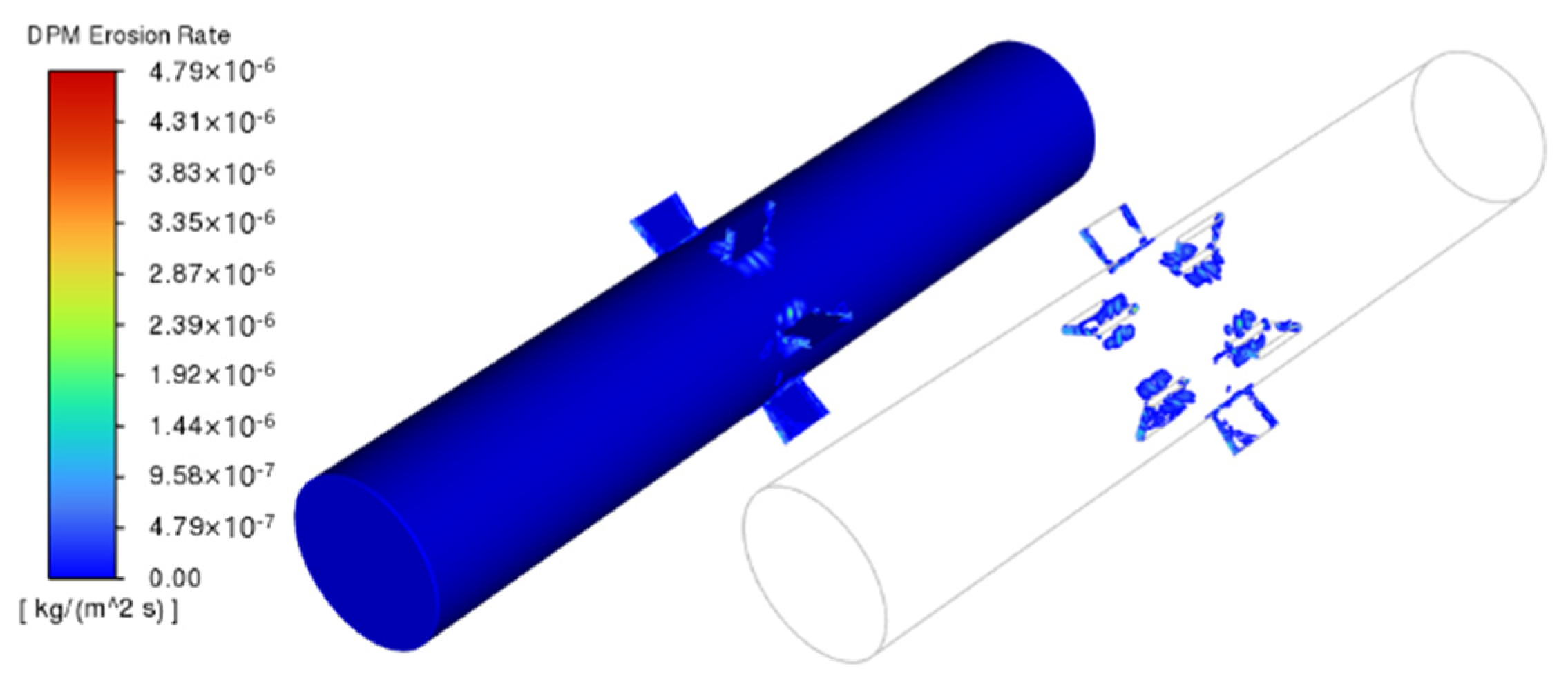


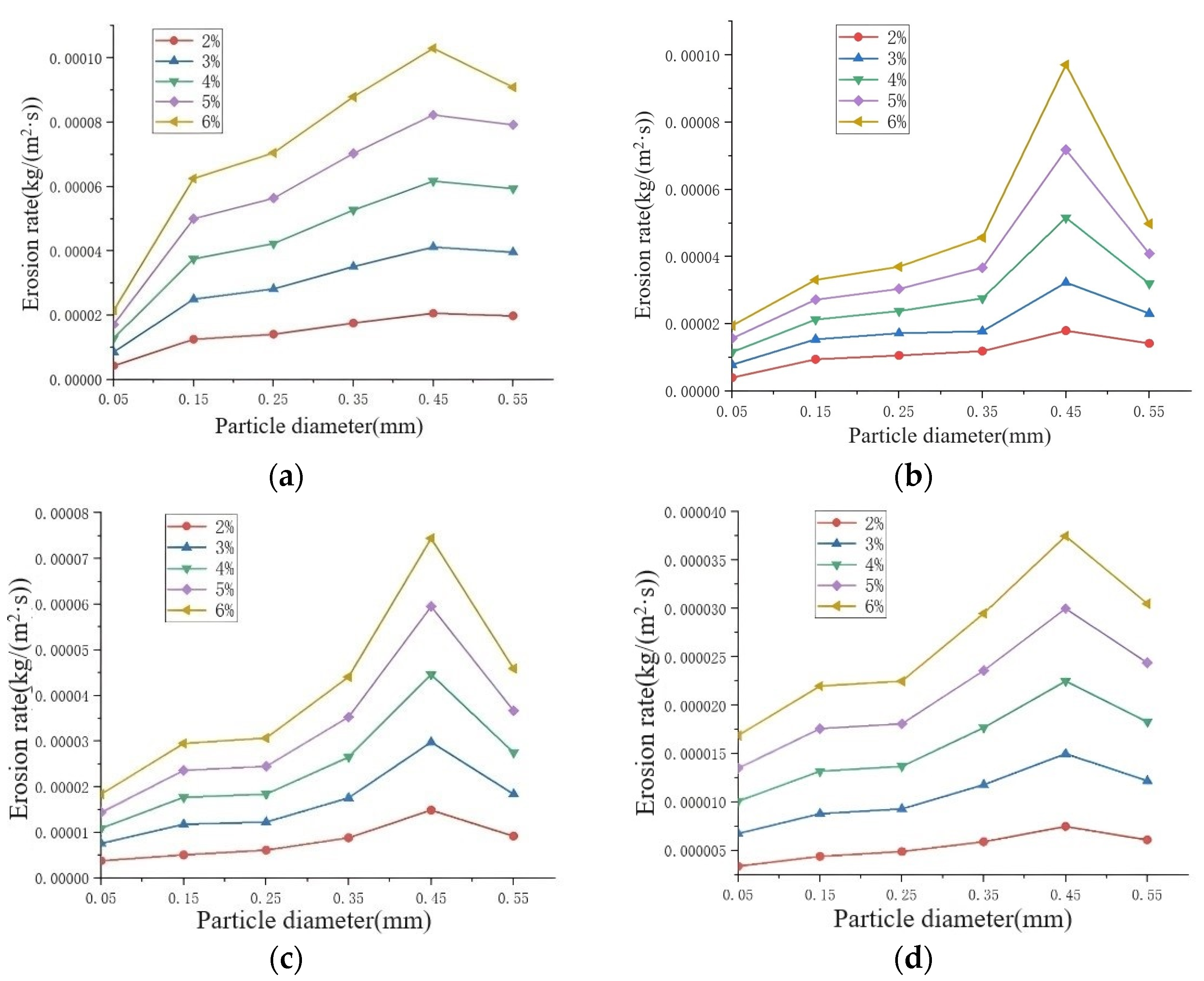
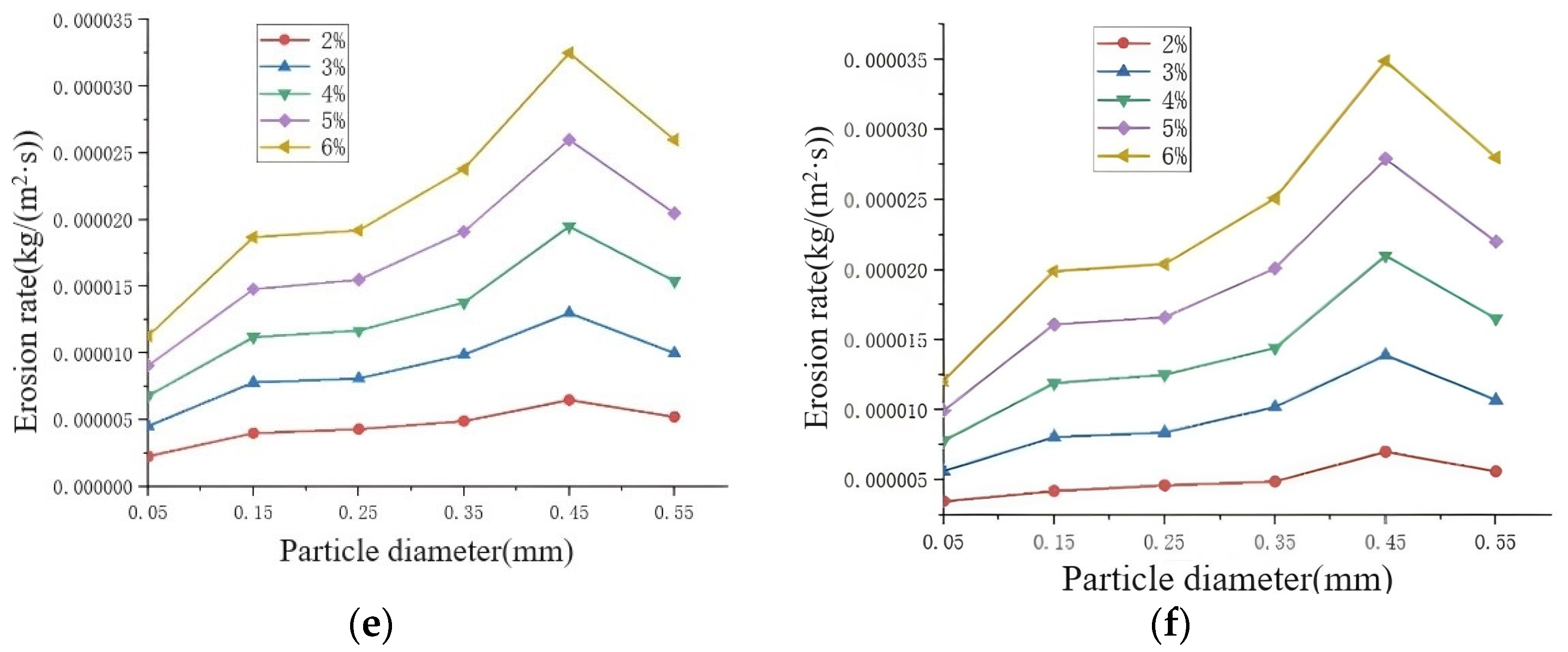



| Angle (°) | Impact Angle Function |
|---|---|
| 0 | 0 |
| 20 | 0.8 |
| 30 | 1 |
| 45 | 0.5 |
| 90 | 0.4 |
| Number of Grids | Maximum Flow Velocity (m/s) | Rate of Change |
|---|---|---|
| 621,452 | 69.11 | -- |
| 754,215 | 69.81 | 1.01% |
| 885,456 | 70.38 | 0.82% |
| 1,045,741 | 70.40 | 0.03% |
| 1,202,101 | 70.41 | 0.01% |
| 1,321,520 | 70.45 | 0.06% |
| Shape | Differential Pressure (MPa) |
|---|---|
| Elliptic | 0.261 |
| Circular | 0.291 |
| Rectangular | 0.332 |
| Inverted trapezoid | 0.376 |
| Trapezoid | 0.394 |
| Working Medium | Taper (°) | Inlet Velocity (m/s) | Outlet Pressure (MPa) | Turbulence Intensity (%) | Hydraulic Diameter (mm) | ||
|---|---|---|---|---|---|---|---|
| Inlet | Outlet | Inlet | Outlet | ||||
| Natural gas | 0 | 18 | 0 | 2.1 | 2.5 | 8.9 | 108 |
| 5 | 2.1 | 2.5 | 8.9 | 108 | |||
| 10 | 2.1 | 2.5 | 9.1 | 108 | |||
| 15 | 2.2 | 2.5 | 9.18 | 108 | |||
| 20 | 2.2 | 2.5 | 9.27 | 108 | |||
| 25 | 2.2 | 2.5 | 9.34 | 108 | |||
| Sand | Density (kg/m3) | Sand particle size (mm) | Mass flow rate (volume fraction) (kg/s) | Particle size function | Impact velocity function | ||
| 1550 | 0.05~0.75 | 0.005, 0.01, 0.015, 0.02, 0.025 | 4.2 × 10−9 | 1.73 | |||
Disclaimer/Publisher’s Note: The statements, opinions and data contained in all publications are solely those of the individual author(s) and contributor(s) and not of MDPI and/or the editor(s). MDPI and/or the editor(s) disclaim responsibility for any injury to people or property resulting from any ideas, methods, instructions or products referred to in the content. |
© 2024 by the authors. Licensee MDPI, Basel, Switzerland. This article is an open access article distributed under the terms and conditions of the Creative Commons Attribution (CC BY) license (https://creativecommons.org/licenses/by/4.0/).
Share and Cite
Zhao, J.; Zheng, H.; Xie, C.; Peng, H. Research on the Throttling Performance and Anti-Erosion Structure of Trapezoidal Throttle Orifices. Energies 2024, 17, 3196. https://doi.org/10.3390/en17133196
Zhao J, Zheng H, Xie C, Peng H. Research on the Throttling Performance and Anti-Erosion Structure of Trapezoidal Throttle Orifices. Energies. 2024; 17(13):3196. https://doi.org/10.3390/en17133196
Chicago/Turabian StyleZhao, Jianguo, Haotian Zheng, Chong Xie, and Hanxiu Peng. 2024. "Research on the Throttling Performance and Anti-Erosion Structure of Trapezoidal Throttle Orifices" Energies 17, no. 13: 3196. https://doi.org/10.3390/en17133196




